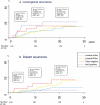Correlation of tumour subtype with long-term outcome in small breast carcinomas: a Swedish population-based retrospective cohort study
- PMID: 35933487
- PMCID: PMC9464733
- DOI: 10.1007/s10549-022-06691-4
Correlation of tumour subtype with long-term outcome in small breast carcinomas: a Swedish population-based retrospective cohort study
Abstract
Purpose: To investigate if molecular subtype is associated with outcome in stage 1 breast cancer (BC).
Methods: Tissue samples from 445 women with node-negative BC ≤ 15 mm, treated in 1986-2004, were classified into surrogate molecular subtypes [Luminal A-like, Luminal B-like (HER2-), HER2-positive, and triple negative breast cancer (TNBC)]. Information on treatment, recurrences, and survival were gathered from medical records.
Results: Tumour subtype was not associated with overall survival (OS). Luminal B-like (HER2-) and TNBC were associated with higher incidence of distant metastasis at 20 years (Hazard ratio (HR) 2.26; 95% CI 1.08-4.75 and HR 3.24; 95% CI 1.17-9.00, respectively). Luminal B-like (HER2-) and TNBC patients also had worse breast cancer-specific survival (BCSS), although not statistically significant (HR 1.53; 95% CI 0.70-3.33 and HR 1.89; 95% CI 0.60-5.93, respectively). HER2-positive BC was not associated with poor outcome despite no patient receiving HER2-targeted therapy, with most of these tumours being ER+.
Conclusions: Stage 1 TNBC or Luminal B-like (HER2-) tumours behave more aggressively. Women with HER2+/ER+ tumours do not have an increased risk of distant metastasis or death, absent targeted treatment.
Keywords: Breast cancer; Long-term outcome; Molecular subtypes; TMA.
© 2022. The Author(s).
Conflict of interest statement
All author declares that they have no conflict of interest.
Figures
Similar articles
-
Long-term treatment patterns and survival in metastatic breast cancer by intrinsic subtypes - an observational cohort study in Sweden.BMC Cancer. 2022 Sep 22;22(1):1006. doi: 10.1186/s12885-022-10098-1. BMC Cancer. 2022. PMID: 36138404 Free PMC article.
-
The impact of molecular subtype on breast cancer recurrence in young women treated with contemporary adjuvant therapy.Breast J. 2018 Mar;24(2):148-153. doi: 10.1111/tbj.12853. Epub 2017 Jul 14. Breast J. 2018. PMID: 28707744
-
Long-Term Outcomes of Immunohistochemically Defined Subtypes of Breast Cancer Less Than or Equal to 2 cm After Breast-Conserving Surgery.J Surg Res. 2019 Apr;236:288-299. doi: 10.1016/j.jss.2018.11.028. Epub 2018 Dec 27. J Surg Res. 2019. PMID: 30694768
-
Therapy response and prognosis of patients with early breast cancer with low positivity for hormone receptors - An analysis of 2765 patients from neoadjuvant clinical trials.Eur J Cancer. 2021 May;148:159-170. doi: 10.1016/j.ejca.2021.02.020. Epub 2021 Mar 18. Eur J Cancer. 2021. PMID: 33743484
-
Distribution of molecular breast cancer subtypes among Algerian women and correlation with clinical and tumor characteristics: a population-based study.Breast Dis. 2015;35(2):95-102. doi: 10.3233/BD-150398. Breast Dis. 2015. PMID: 25736840
Cited by
-
Recent Advances in Optimizing Radiation Therapy Decisions in Early Invasive Breast Cancer.Cancers (Basel). 2023 Feb 16;15(4):1260. doi: 10.3390/cancers15041260. Cancers (Basel). 2023. PMID: 36831598 Free PMC article. Review.
-
A Novel Compound from the Phenylsulfonylpiperazine Class: Evaluation of In Vitro Activity on Luminal Breast Cancer Cells.Molecules. 2024 Sep 20;29(18):4471. doi: 10.3390/molecules29184471. Molecules. 2024. PMID: 39339466 Free PMC article.
-
Targeting collagen XVIII improves the efficiency of ErbB inhibitors in breast cancer models.J Clin Invest. 2023 Sep 15;133(18):e159181. doi: 10.1172/JCI159181. J Clin Invest. 2023. PMID: 37498672 Free PMC article.
-
Strict definition of a small tumor in breast cancer should be revisited.Breast Cancer Res Treat. 2022 Nov;196(1):241. doi: 10.1007/s10549-022-06734-w. Epub 2022 Sep 2. Breast Cancer Res Treat. 2022. PMID: 36056296 No abstract available.
References
-
- Sorlie T, Perou CM, Tibshirani R, Aas T, Geisler S, Johnsen H, Hastie T, Eisen MB, van de Rijn M, Jeffrey SS, et al. Gene expression patterns of breast carcinomas distinguish tumor subclasses with clinical implications. Proc Natl Acad Sci USA. 2001;98(19):10869–10874. doi: 10.1073/pnas.191367098. - DOI - PMC - PubMed
-
- Gianni L, Pienkowski T, Im Y-H, Roman L, Tseng L-M, Liu M-C, Lluch A, Staroslawska E, de la Haba-Rodriguez J, Im S-A, et al. Efficacy and safety of neoadjuvant pertuzumab and trastuzumab in women with locally advanced, inflammatory, or early HER2-positive breast cancer (NeoSphere): a randomised multicentre, open-label, phase 2 trial. Lancet Oncol. 2012;13(1):25–32. doi: 10.1016/S1470-2045(11)70336-9. - DOI - PubMed
-
- Hugh J, Hanson J, Cheang MCU, Nielsen TO, Perou CM, Dumontet C, Reed J, Krajewska M, Treilleux I, Rupin M, et al. Breast cancer subtypes and response to docetaxel in node-positive breast cancer: use of an immunohistochemical definition in the BCIRG 001 trial. J Clin Oncol. 2009;27(8):1168–1176. doi: 10.1200/JCO.2008.18.1024. - DOI - PMC - PubMed
MeSH terms
Substances
Grants and funding
LinkOut - more resources
Full Text Sources
Medical
Research Materials
Miscellaneous




